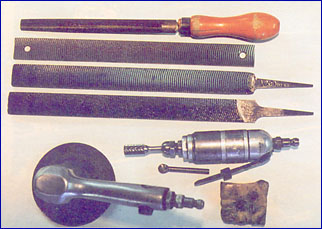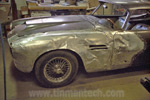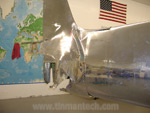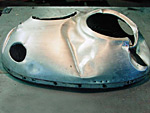Repairing Aluminum: Straightening Damaged Parts
Repairing Aluminum: Straightening Damaged Parts
from Automotive Body Repair News, May 1995
See TM Technologies Aluminum Gas Welding System
EDITOR'S NOTE: This is the second article in a series on working with aluminum. The first installment appeared in January 1995.

Essential aluminum repair tools include:
|
Workablity & Weldability of Alloys
KEY WORDS:-work hardening annealing
-heat treating cold workability
-temper weldability
-annealing
-cold workability
-weldability
As mentioned previously, aluminum is often more workable than steel, depending on the alloy. The 1100 and 3003 aluminum alloys are very nearly pure forms of aluminum and therefore very workable by both hot and cold methods. Neither of these alloys are heat-treated ("T" tempers), but simply work hardened ("H" tempers) to given strengths: 0, H 12, H 14, H16, H32, etc., with the lower numbers indicating lower strengths. The vast majority of aluminum automobile bodies made before 1970 were of either 1100 or 3003 half-hard (H14) sheet in varying thicknesses of 0.040 in. (18 gauge), 0.050 in. ( 15 gauge), and 0.063 in. (14 gauge). Aluminum sheet gauge numbers differ from steel sheet gauge numbers.
With the advent of high-production aluminum body parts and requirements for more strength in the panels, the alloys and their tempers have changed significantly. The alloys now used are tempered either by heat-treating or by work-hardening, and the thicknesses have decreased slightly.
In the following chart of aluminum alloys used in automobile bodies, 1100 has been deleted. Alloy 3003 remains, however, primarily as a weldability and workability reference.
|
Weldability |
|||
|
Aluminum Alloys |
Workability Cold |
Gas |
Inert Gas Arc |
|
2008-T4 |
B |
D |
B |
|
2010-T4 |
B |
D |
B |
|
2036-T4 |
C |
D |
C |
|
3003-H14 |
A |
A |
A |
|
5052-H32 |
B |
B |
A |
|
5182-0 |
A |
D |
A |
|
5454-0 |
A |
C |
A |
|
5754-0 |
A |
C |
A |
|
6009-T4 |
B |
B |
A |
|
6111-T4 |
B |
B |
A |
Use the ``H" or ``T" designation to determine if the alloy is work-hardened or heat-treated. The 1000, 3000 and 5000 aluminum alloys are strengthened by work-hardening ("H" tempers), while the 2000, 6000 and 7000 alloys are heat-treated ("T" tempers).
Let's consider the cold workability of "H" temper material after it has been hardened by a crash.
Straightening it could be a bit tougher then, because of the additional "work" put into it, but these
alloys have high ductility and may straighten without heat. If difficulty is encountered,
|
Workability Cold |
Weldability |
|
A-Easy |
A-Easy |
|
B-Fairly Easy |
B-Fairly Easy |
|
C-Difficult |
C-Difficult |
|
D-Very Difficult |
D-Very Difficult |
With the heat-treated "T" temper materials, the damaged part has a much higher yield strength and will be difficult to reform without the application of heat. Heating for a short time between 350 0~ 50 0 F may be necessary to avoid tearing during straightening.
Annealing is the term used for softening metal with heat. Non-heat treatable aluminum alloys are annealed by heating to 650 0 F and then simply allowing them to cool gradually. Some stress relief may occur as an added benefit. Heat-treated alloys are annealed by heating to 775 0 F for 2-3 hours and cooling slowly to 500 0 E
Note: A safety margin should exist to account for inaccuracy in measuring the heat applied to a panel when using temperature crayons for indicators. This safety margin will compensate for wide variations in shop conditions (windy and cold to warm and still), and the relative heat sinks (coatings, braces, brackets, etc.) that are all associated with final accuracy.



